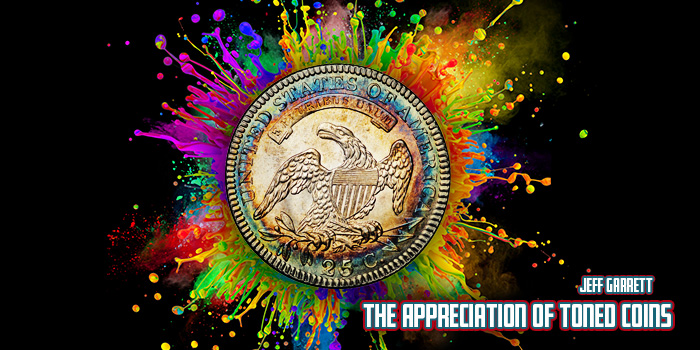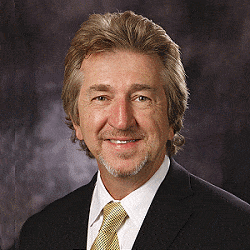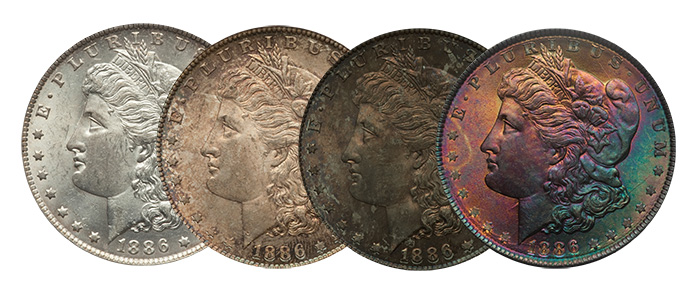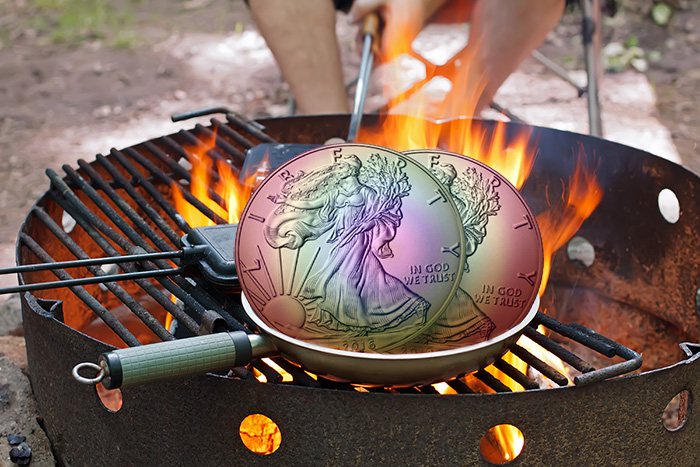
By Jeff Garrett for Numismatic Guaranty Corporation (NGC) ……
 My last article mentioned the high demand from collectors for beautifully toned coins. The prices realized for coins with great color can sometimes defy logic. As someone who spends a lot of time trying to be on top of rare coin prices, this part of the market can be mystifying, even for an expert. I’m sure for those who have much less experience, the subject can be even more difficult, if not downright confusing.
My last article mentioned the high demand from collectors for beautifully toned coins. The prices realized for coins with great color can sometimes defy logic. As someone who spends a lot of time trying to be on top of rare coin prices, this part of the market can be mystifying, even for an expert. I’m sure for those who have much less experience, the subject can be even more difficult, if not downright confusing.
Silver coinage comes in a wide range of appearances. Most collectors state that they only want original coins for their collection, but in many cases only purchase frosty white examples. This is similar to saying you want healthy food, but when asked to order, you choose the bacon cheeseburger. It is not hard to understand this impulse, as frosty white coins are usually very attractive. Coins with great luster can look amazing, and are what the coins looked like the day they left the dies.
Unfortunately, most silver coins, especially those over 100 years old, usually display some level of toning. This can range from light golden hues, to an almost black oxidized appearance. Coins with unattractive toning can sometimes be conserved by dipping in silver tarnish remover, of which there are many brands. Jewel Luster is the most popular brand of silver dip, and has been around for decades. In recent months it has been reported that Jewel Luster was being discontinued by its manufacturer. I’m not sure if this is true, but quite a few dealers have stocked up, just in case.
Enhancing Eye Appeal
Using silver dip can be a dangerous option for toned silver coins of high value. The results are far from consistent, and many great coins have been ruined in an attempt to make them frosty white. I still have a 1923 Monroe Half Dollar that I purchased in the 1980s for around $3,000 that was completely ruined when I dipped the coin. I keep the coin as a reminder of the dangers when trying to restore a coin.
Nearly every dealer you will meet can relate a similar story. On the flip side, there is always the excitement of dipping an unattractive coin and being left with a sparkling jewel.
Coin conservation really should be left to experts as the results can be extremely erratic. Luckily, NGC started Numismatic Conservation Services (NCS) years ago to assist collectors in this tricky part of the hobby. The most important function they serve is to help you avoid ruining a coin with aggressive cleaning techniques. If a coin is not a good candidate for conservation, they will let you know.
For most, the confusing part of toned coins is what can be considered attractive toning. There is no formalized scale or standard reference book on the subject. Price guides do not have an extra column for toned coins. The variables are staggering and opinions on the subject range wildly.
As a collector, you really need to have a grasp of this subject, because when it’s time to sell your coins, the eye appeal factor will be an important issue. I have known far too many collectors who focus more on completing a collection and too little on quality.
Beauty Is Subjective
Beauty is in the eye of the beholder in numismatics. Some like bright white examples, and others love toned coins. It’s the middle ground that gets ignored, especially when the market is dominated by collectors, as is the case at the moment.

I believe the danger is when you are faced with a buying decision for an attractive coin at what seems to be an excessive price. This is where you need to understand market pricing to make the right decision. This is information you cannot find in a book. You need to study actual coins and observe what they sell for. This is best accomplished by examining auction results — either in person or on the web. Most companies have great photography these days.
I have also mentioned many times the importance of finding an experienced mentor for your collecting pursuits. In most cases, these individuals have decades of experience that they are willing to share. There are many aspects of numismatics that can only be learned by seeing thousands upon thousands of coins. A relationship with someone who knows their area of the market can be vital to your long-term success as a collector. They can help you navigate some of the traps that other collectors sometimes fall into.
Artificial Toning
Speaking of traps, artificial toning is one of the trickiest parts of numismatics. Anyone who has ever submitted coins to a grading service has probably gotten a coin back that was ungraded because of “questionable toning”. Coins have been artificially toned since the beginning of numismatics. In the late 1800s, a prominent numismatist died when cleaning large cents. He accidentally took a sip of cyanide instead of ginger ale while working on his collection.

Getting a coin back from the grading services as “questionable toning” can be frustrating for anyone. It’s understandable, in my opinion, as the grading services are constantly assaulted with artificially enhanced coins. It is their job to protect the final end user of their products. No one wants to own a coin for years and then find out they have an inferior product when it’s time to sell.
Collecting coins is enjoyable in many ways. Most coins are related to events in history and many have great stories to tell. The hobby can provide a lifetime of enjoyment, but to be a successful collector (someone who hopes their collection is a good investment), you need to spend time trying to learn the nuances of the hobby.
Numismatic education is vital and will pay great rewards when it comes time to sell. Consider joining the American Numismatic Association (ANA). The organization is based on numismatic education. Even better, you should try attending their annual Summer Seminar in Colorado Springs. There are classes on tons of subjects, including most of what has been discussed above. This one-week submersion in numismatics is amazing. Knowledge is power, especially in numismatics!
* * *





